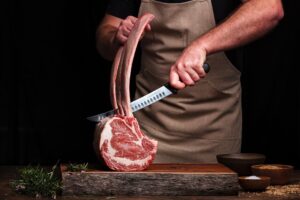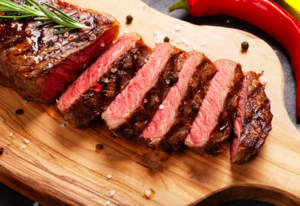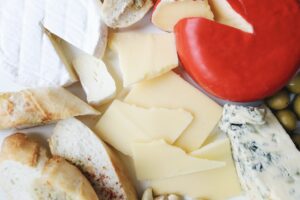Goat cheese is what we love, and what many people refuse, which is a similar point to blue cheese. This is because goat cheese typically tastes more intense with a distinctive tart flavor. Yet, there are many different types of goat cheese that have their own characteristics in terms of texture and flavors. Here, we’re gonna introduce 13 types of our favorite goat cheese to you. Let’s go!
► Before diving into different types of goat cheese, you may want to read: What Is Goat Cheese? Is It a Dairy? | FAQs of Goat Cheese
Table of Contents
1. Le Chevrot (French Goat Cheese)
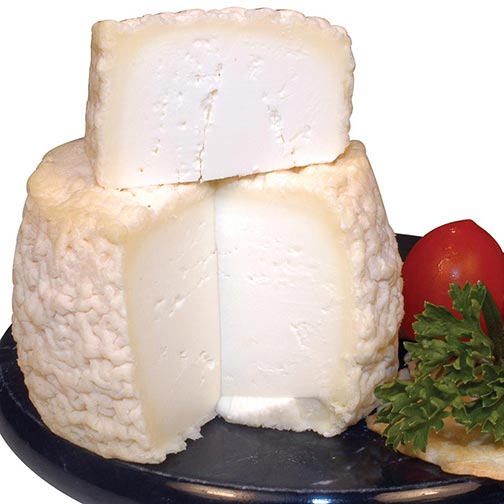
Milk Type: Goat
Pasteurised: No
Aging Time: Fresh / Less than 40 days
Texture: Soft
Country of Origin: Poitou, France
What Is Le Chevrot?
Le Chevrot is one of the most famous types of goat cheese that is top of mind whenever talking about goat cheese. It is raw goat milk cheese that comes from central western France. It looks like an elderly because of its edible and natural wrinkled rind. But in fact, Le Chevrot is a young cheese which is only aged for 20 to 40 days, or even sold as fresh. And the body is smooth, dense and soft, tastes creamy, nutty and fruity but not strongly goaty. The mildness of goaty flavor makes it a great choice for those who are new to goat cheese.
Characteristics of Le Chevrot
- Wrinkled Rind
- Smooth, Dense and Soft
- Creamy
- Nutty and Fruity
- Mildly Goaty
How to Enjoy Le Chevrot?
Le Chevrot with honey is snackable which combines a slight goat taste as well as a fresh sweetness together that is fantastic. For the drinks, French champagne and white wine are the best choices.
2. Chabichou du Poitou (French Goat Cheese)
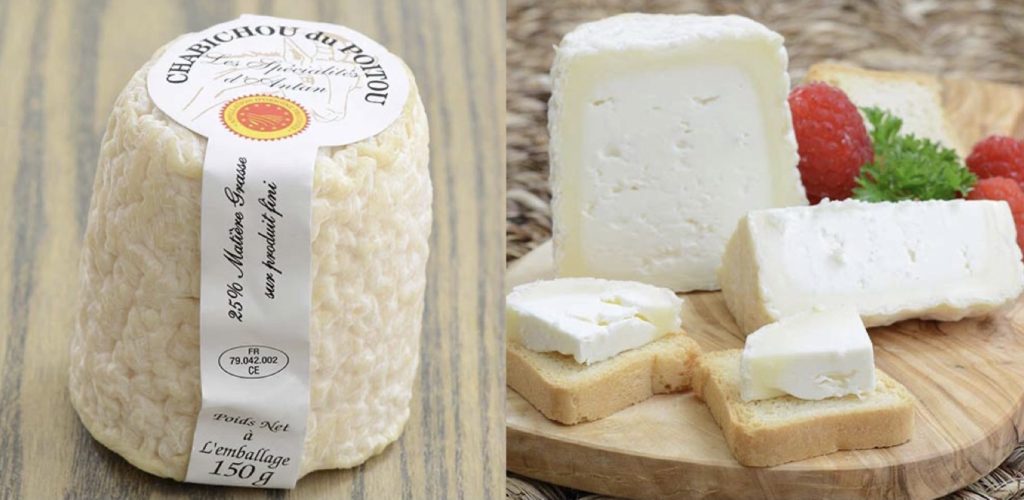
Milk Type: Goat
Pasteurised: No
Aging Time: 2 to 6 weeks
Texture: Semi-soft
Country of Origin: France
What Is Chabichou du Poitou?
Chabichou du Poitou looks quite similar to Le Chevrot since both of them have a white or pale yellow edible wrinkled rind. However, Chabichou tends to be a truncated cylinder and firmer in texture.
This French goat cheese is smooth and creamy with a fine goaty aroma. It tastes freshly sweet with a slightly salty and tangy finish. And it will become more savory, piquant and nutty when older.
Characteristics of Chabichou du Poitou
- Smooth and Creamy
- Sweet
- Slightly Salty and Tangy
- Nutty
How to Enjoy Chabichou du Poitou?
Chabichou du Poitou works well with fig jam and champagne or light white wine.
3. Crottin de Champcol (French Goat Cheese)
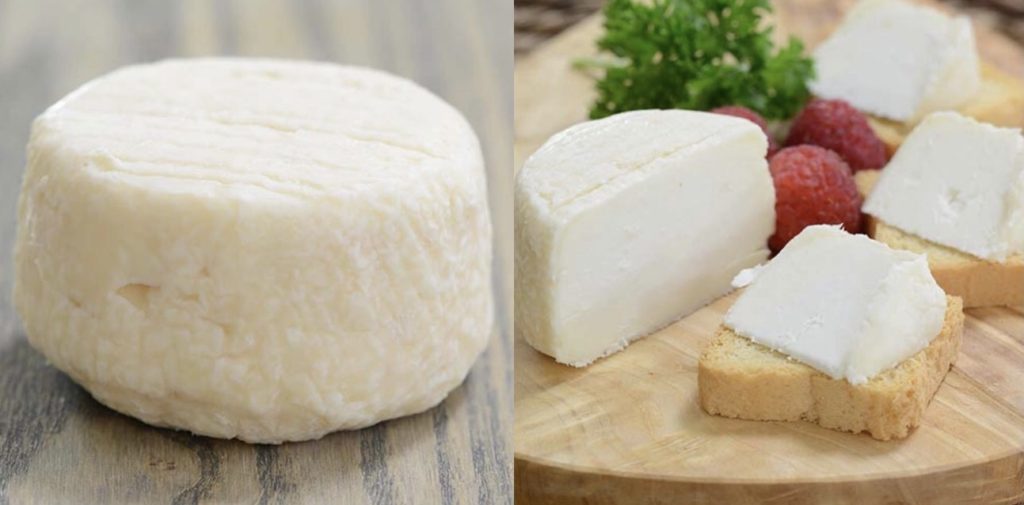
Milk Type: Goat
Pasteurised: Yes
Aging Time: 4 to 6 weeks
Texture: Soft
Country of Origin: France
What Is Crottin de Champcol?
Crottin de Champcol is a French goat cheese originating from the little village Champcol in Loire Valley, where it is renowned for wines and cheeses. It is a pasteurized version of another French cheese, Crottin de Chavignol. Crottin de Champcol is a small cheese that only weighs about 2 oz (60 g) while the older one tends to be lighter due to moisture loss.
Apart from the weight, the taste and texture changes at different ages as well. When it’s young, it has an ivory rind with a soft, creamy body that tastes sweet and slightly nutty. As it matures, the rind turns darker and mold appears; the body becomes harder; and tastes stronger, more goaty and pungent.
Characteristics of Crottin de Champcol
- Soft and Creamy
- Young: Sweet and Slightly Nutty
- Old: Strong, Goaty, Pungent
How to Enjoy Crottin de Champcol?
Crottin de Champcol stands out on any cheese board. It is also great to serve with fruits and Sancerre wine.
4. Pico (French Goat Cheese)
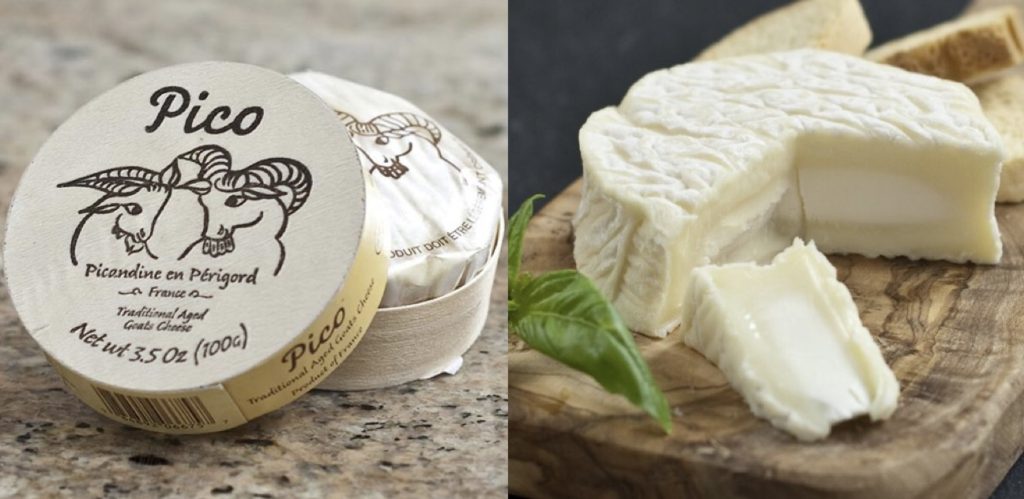
Milk Type: Goat
Pasteurised: Yes
Aging Time: 1 to 2 months
Texture: Semi-soft
Country of Origin: Périgord, France
What Is Pico?
Pico is a soft-ripened cheese with mold that is usually compared to Camembert, both of them come from France. Some people regard it as a tiny, goat version of Camembert.
This cheese has a slightly wrinkled surface with a creamy, dense, firm and melty interior. The flavors of Pico are quite complex. It is mild, tangy, mineraly, mushroomy and richly earthy. You can taste the touches of wet stone and freshly hayed barn floor or kind of forest floor.
Characteristics of Pico
- Creamy, Dense, Firm and Melty
- Mild and Tangy
- Mineraly, Mushroomy, Earthy
How to Enjoy Pico?
Pico cheese is fabulous to be on a cheeseboard. Alternatively, it is bravo to serve as an aperitif snack, pair it with wines like Cahors and Bergerac or fruity champagne.
5. Garrotxa (Spanish Goat Cheese)
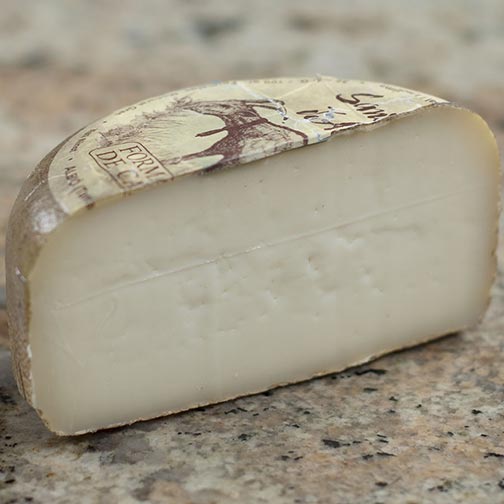
Milk Type: Murciana goats’ milk
Pasteurised: Yes
Aging Time: 4 to 8 weeks
Texture: Semi-firm
Country of Origin: Garrotxa, Catalonia
What Is Garrotxa?
Garrotxa is a traditional goat cheese from Catalonia, Spain. It was almost extinct in the early 1980s, and luckily revived by the local cheese makers and goat farmers. Garrotxa is made from milk of Murciana goats and aged in caves. It matures fast owing to the relatively small wheel size.
This artisanal Catalan cheese has a powdery gray rind and an ivory body. It is soft but firm, tastes smooth, gentle, slightly earthy and acidic. Since it is not strong and sharp but aromatic, it’s versatile and you can easily find it in many Catalan dishes.
Characteristics of Garrotxa
- Soft but Firm
- Smooth and Gentle
- Earthy
- Mildly Acidic
How to Enjoy Garrotxa?
Garrotxa matches flawlessly with crusty country bread and various nuts like hazelnuts, walnuts and almonds. Drinks that pair well with Garrotxa include Pinot Gris, Chardonnay and sherry.
6. Leonora (Spanish Goat Cheese)

Milk Type: Murciana goats’ milk
Pasteurised: Yes
Aging Time: 3 months
Texture: Semi-soft
Country of Origin: Spain
What Is Leonora?
Leonora cheese is a comparatively new creation that is significant to the recent renaissance in Spanish cheesemaking. It is made from the milk of Murciana goats in the northwestern mountainous region of Spain.
It has a brick shape, a bloomy white rind and a bone white body. The mouthfeel of this cheese is smooth, dense and creamy; and it tastes lactic and lemony which are contributed by the lactic fermentation process. As it ripens, the paste begins to break down and turns more runny, intense and mushroomy.
Characteristics of Leonora
- Smooth, Dense and Creamy
- Lactic and Lemony
- Mushroomy
How to Enjoy Leonora?
Leonora cheese is highly versatile. It goes well with many foods ranging from nuts and honey to cakes and omelette. Also, any sparkling drinks match amazingly with it.
7. Cabrales (Spanish Goat Cheese)

Milk Type: Cow / Goat / Sheep
Pasteurised: No
Aging Time: 2 to 4 months
Texture: Semi-hard
Country of Origin: Spain
What Is Cabrales?
Cabrales comes from Spain and is protected with Protected Designation of Origin (PDO) status like many famous cheeses. Traditionally, the cheese makers would wrap it in moist maple leaves. But nowadays, to get the PDO stamp, it’s required using dark-green aluminum foil to pack. Sometimes, you may see it with the name tags Quesu Cabrales or Cabraliego that are literally the same things.
It is made from cow milk or blended with goat and sheep milk, and it’s aged naturally in limestone caves. The aging process in humid caves facilitates penicillium molds and hence beautiful blue veins. Therefore, it has a complex flavor combining both the features of goat and blue cheese, while using mixed milks is even more complicated. This Spanish blue goat cheese is penetratingly strong and sharp with a slightly acidic and salty taste.
Characteristics of Cabrales
- Blue Veins
- Complex
- Strong and Sharp
- Slightly Acidic and Salty
How to Enjoy Cabrales?
Cabrales perfectly complement diverse foods, for example, salami, grilled meats, baguette, crackers and fresh fruits. It is also bravo with red wine and sweet sherry.
► Read More: What Is Blue Cheese? How It Is Made? | FAQs of Blue Cheese
► Read More: 11 Best Types of Blue Cheese From Mild to Sharp
8. Monte Enebro (Spanish Goat Cheese)
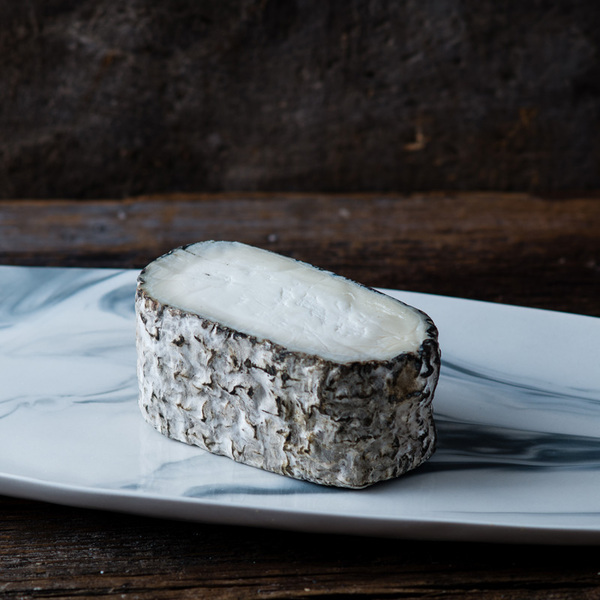
Milk Type: Goat
Pasteurised: Yes
Aging Time: 1 to 2 months
Texture: Semi-soft
Country of Origin: Avila, Spain
What Is Monte Enebro?
Monte Enebro is an important creation of the Spanish new cheese wave. It has a moldy rind since penicillium roqueforti is used which is the mold to produce many blue cheeses. However, dissimilarly, making Monte Enebro does not pierce the cheese. Therefore, the blue mold only grows on the rind but not throughout the whole cheese.
On the other hand, the paste is dense; a bit chalky and brittle when young; and turns to runny due to break down as it ages.
This Spanish goat cheese tastes mild and tangy with citrus touches, plus cellar-like aroma given by the blue rind. The older Monte Enebro has richer and more pungent goaty flavors.
Characteristics of Monte Enebro
- Blue Mold Rind: Cellar-like Aroma
- Young: a bit Chalky and Brittle
- Old: Runny and Richer
- Mild and Tangy
- With Citrus Touches
How to Enjoy Monte Enebro?
Surprisingly, Monte Enebro matches exceptionally well with Nutella. It also tastes good on salad or some greens. Sauternes or a Spanish dessert wine are nice with it as well.
9. Bijou (US Goat Cheese)
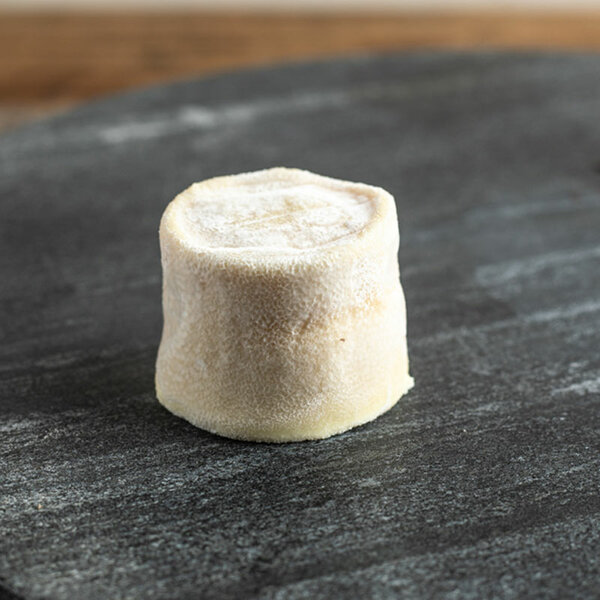
Milk Type: Goat
Pasteurised: Yes
Aging Time: 30 days
Texture: Semi-soft
Country of Origin: Vermont, United States
What Is Bijou?
Bijou means “jewel” in French, but it was just French-inspired and actually invented in Vermont, US. To make this cheese, the artisans ladle the curds by hand and coagulate it overnight, and then drain gradually. After 30 days of ripening, the cheese develops complex flavors. Bijou cheese is smooth and creamy, and tastes sweet, yeasty, tangy with touches of hazelnuts as well as fresh flowers.
Characteristics of Bijou
- Smooth and Creamy
- Sweet and Yeasty
- Tangy
- Touches of Hazelnuts and Fresh Flowers
How to Enjoy Bijou?
Bijou is excellent to be served with a baguette or salad. It also fits meats such as pancetta and applewood bacon. For the drinks, pick amber cider.
10. Humboldt Fog (US Goat Cheese)

Milk Type: Goat
Pasteurised: Yes
Aging Time: 60 days
Texture: Semi-soft
Country of Origin: United States
What Is Humboldt Fog?
Humboldt Fog is named after its origin, Humboldt County, California. It is a mold-ripened cheese which develops a bloomy mold exterior and a signature ash line running through the center (look like Morbier cheese). Many people think it is blue cheese, but it’s not actually.
Initially, the interior is crumbly and becomes soft and creamy as it ripens. Humboldt Fog is light and slightly acidic with hints of citrus and herbs. The flavors get stronger near the rind.
Characteristics of Humboldt Fog
- Bloomy Rind with Ash Line
- Soft and Creamy
- Light
- Slightly Acidic
- Hints of Citrus and Herbs
How to Enjoy Humboldt Fog?
Enjoy Humboldt Fog cheese with blueberries and a cup of yeasty wheat beer!
11. Lake’s Edge (US Goat Cheese)
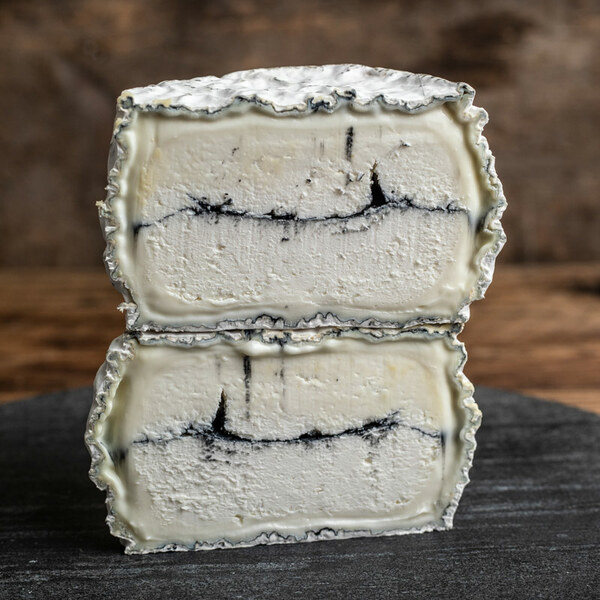
Milk Type: Goat
Pasteurised: Yes
Aging Time: 3 to 6 weeks
Texture: Soft
Country of Origin: Vermont, United States
What Is Lake’s Edge?
Lake’s Edge takes its name from the commonly found stones along Lake Champlain. It is made from the milk of a mixed herd of Alpine and LaMancha goats from Blue Ledge Farm in Vermont. Thanks to the nice environment, the milk is creamy, grassy and mineraly which also affects the cheese.
This goat cheese looks quite similar to Humboldt Fog since they both are mold-ripened and have a bloomy rind with an ash central line. And smart as you will know, it’s not blue cheese too!
Lake’s Edge is creamy, fluid, melty and dense inside. And it tastes goaty, mineraly, tart, sweet, and fresh although it’s semi-aged.
Characteristics of Lake’s Edge
- Bloomy Rind with an Ash Central Line
- Creamy, Fluid, Melty, Dense
- Goaty, Tart, Sweet, Mineraly, Fresh
How to Enjoy Lake’s Edge?
Light red wine like Pinot Noir is unbeatable with Lake’s Edge.
12. Brabander Cheese (Dutch Goat Cheese)
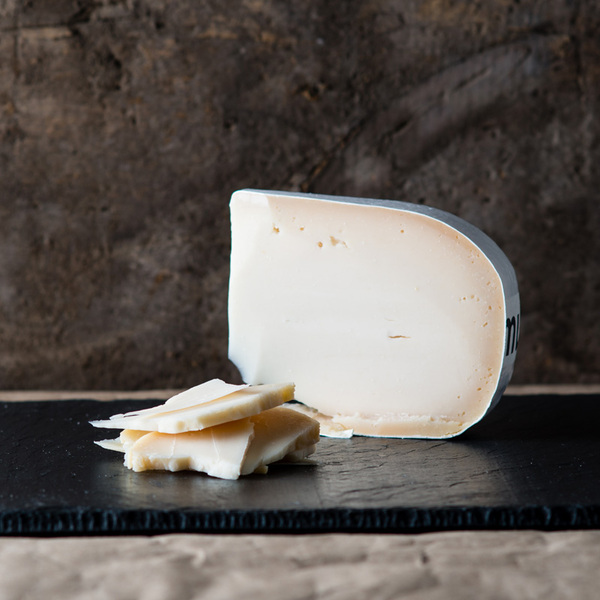
Milk Type: Goat
Pasteurised: Yes
Aging Time: 6 to 9 months
Texture: Hard
Country of Origin: The Netherlands
What Is Brabander Cheese?
Brabander Cheese is a kind of goat milk gouda from the Netherlands. Generally, goat cheese has a softer texture but Brabander is an exception. It belongs to hard goat cheese types. It is aged in a thin white wax exterior under higher humidity level and temperature (up to 60°F) less than a year. Therefore, these conditions form crystals and preserve its moistness and keep it fudgy.
This ivory goat gouda is dense and smooth and speckled with crystals. The flavors are caramel-butterscotch sweet and nutty, plus a bit of salty and acidic edge at the end. There is just a trace of tang that makes it a good beginner’s choice of goat cheese.
Characteristics of Brabander Cheese
- Fudgy, Dense and Smooth
- Speckled with Crystals
- Caramel-butterscotch Sweet
- Nutty
- A bit of Salty and Acidic
How to Enjoy Brabander Cheese?
Brabander and cherry are a perfect match. Anything cherry can lift this Dutch cheese to the next level, from cherry jam to cherry lambic beer. For the drinks, Stout, Porter, Pinot Noir or Beaujolais are great.
13. Feta (Greek Goat Cheese)
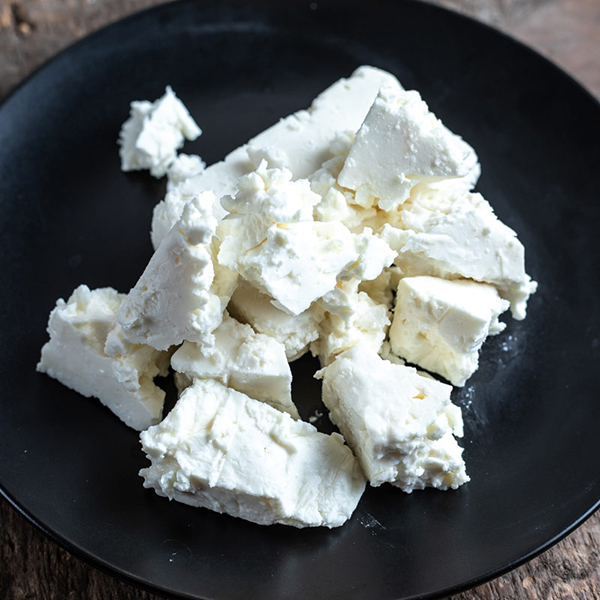
Milk Type: Sheep / Sheep+Goat
Pasteurised: Depends on variety
Aging Time: At least 3 months
Texture: Depends on variety
Country of Origin: Greece
What Is Feta Cheese?
Feta is one of the non-pure goat cheese types sourced from Greece. It is traditionally made from sheep milk or a blend of sheep and goat milk, in which at most 30% of goat milk. It is a brined cheese which means it is salted and aged in brine. That’s why it doesn’t have skin and is salty as well as white in color; and so often called “white cheese”.
For the texture, it can be soft or firm depending on varieties. Generally speaking, the firm one tastes sharper and more valuable while the soft version is nearly spreadable and cheaper. In most cases, the Feta is crumbly, compact and slightly grainy, and sometimes with small holes.
For the flavors, it is salty and tangy ranging from mild to sharp, with a spiciness in the finish which resembles ginger and pepper.
To store this Greek cheese, do keep it in brine since it dries quickly.
Characteristics of Feta
- Crumbly, Compact, Slightly Grainy
- Salty
- Tangy
- Spicy
How to Enjoy Feta?
Feta cheese is often used on dishes because it provides saltiness and goaty cheese flavor at the same time. It is great in salads, olives, sandwiches, omelettes etc.
If you buy on GourmetFoodStore.com, use our unique discount code: KitchenTeller on the Basket page or the Payment page during checkout to enjoy 10% OFF!
If you buy on Di Bruno Bros, click HERE to check the latest discount!
Summary Chart of Different Types of Goat Cheese
| Goat Cheese | Origin | Pasteurised | Aging Time | Texture | Characteristics |
| Le Chevrot | France | No | Fresh / Less than 40 days | Soft | Wrinkled Rind Smooth, Dense and Soft Creamy Nutty and Fruity Mildly Goaty |
| Chabichou du Poitou | Fance | No | 2 to 6 weeks | Semi-soft | Smooth and Creamy Sweet Slightly Salty and Tangy Nutty |
| Crottin de Champcol | France | Yes | 4 to 6 weeks | Soft | Soft and Creamy Young: Sweet and Slightly Nutty Old: Strong, Goaty, Pungent |
| Pico | France | Yes | 1 to 2 months | Semi-soft | Creamy, Dense, Firm and Melty Mild and Tangy Mineraly, Mushroomy, Earthy |
| Garrotxa | Spain | Yes | 4 to 8 weeks | Semi-firm | Soft but Firm Smooth and Gentle Earthy Mildly Acidic |
| Leonora | Spain | Yes | 3 months | Semi-soft | Smooth, Dense and Creamy Lactic and Lemony Mushroomy |
| Cabrales | Spain | No | 2 to 4 months | Semi-hard | Blue Veins Complex Strong and Sharp Slightly Acidic and Salty |
| Monte Enebro | Spain | Yes | 1 to 2 months | Semi-soft | Blue Mold Rind: Cellar-like Aroma Young: a bit Chalky and Brittle Old: Runny and Richer Mild and Tangy With Citrus Touches |
| Bijou | United States | Yes | 30 days | Semi-soft | Smooth and Creamy Sweet and Yeasty Tangy Touches of Hazelnuts and Fresh Flowers |
| Humboldt Fog | United States | Yes | 60 days | Semi-soft | Bloomy Rind with Ash Line Soft and Creamy Light Slightly Acidic Hints of Citrus and Herbs |
| Lake’s Edge | United States | Yes | 3 to 6 weeks | Soft | Bloomy Rind with an Ash Central Line Creamy, Fluid, Melty, Dense Goaty, Tart, Sweet, Mineraly, Fresh |
| Brabander Cheese | The Netherlands | Yes | 6 to 9 months | Hard | Fudgy, Dense and Smooth Speckled with Crystals Caramel-butterscotch Sweet Nutty A bit of Salty and Acidic |
| Feta | Greece | Depends on variety | At least 3 months | Depends on variety | Crumbly, Compact, Slightly Grainy Salty Tangy Spicy |
Conclusion
You’ve just finished this guide of different types of goat cheese. And do you have any preference now? Why not try it? Pick one from the above types of goat cheese and dive into this amazing new world!
► Read More: What & How Cheese Is Made? | Cheese Beginner’s Guide
► Read More: 20+ Types of Cheese Must To Know | The Most Complete Cheese Guide


